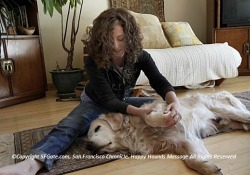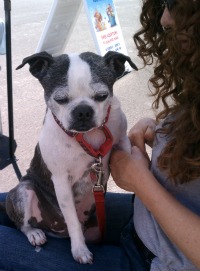The Basics of Canine Massage and Chiropractic
Both Americans and their pets are living longer lives than ever. This auspicious fact has helped bolster an increased interest in wellness maintenance and preventative care, leading to greater demand for alternative and complementary therapies. Long employed by people, massage and chiropractic have begun to enjoy greater popularity as part of a well-rounded wellness regimen for dogs of all ages.
 The use of both massage and chiropractic dates back to the beginning of recorded time. References appear in writings from ancient civilizations, including China and Greece. Hippocrates, widely regarded as the father of Western medicine, cited both as important areas of study. As their use has evolved and expanded, both massage and chiropractic have become increasingly recognized as helpful tools for detecting, alleviating, and preventing the recurrence of conditions that limit or debilitate physical movement and overall good health.
The use of both massage and chiropractic dates back to the beginning of recorded time. References appear in writings from ancient civilizations, including China and Greece. Hippocrates, widely regarded as the father of Western medicine, cited both as important areas of study. As their use has evolved and expanded, both massage and chiropractic have become increasingly recognized as helpful tools for detecting, alleviating, and preventing the recurrence of conditions that limit or debilitate physical movement and overall good health.
The theories and principles that guide massage and chiropractic are nearly the same for animals as they are for humans. Because it is comprised of multiple techniques and varieties from different cultures, massage can be broadly defined as the practice of using touch, including pressing, rubbing, kneading, and tapping, for the purposes of relief and healing. While humans have used massage on their companion animals for as long as they have practiced it, animal massage didn’t rise to prominence in America until the 1970s. Beginning with horses and growing to include dogs and other animals, it has continued to grow in popularity.
Chiropractic restores and maintains good health by treating disorders of the musculoskeletal and nervous systems without the use of drugs or surgery. Disorders or misalignments of the spine, known as subluxations, affect the nervous system, muscles, joints, organs, and body functions.
Chiropractic, or spinal, adjustments are the most common chiropractic treatment for subluxations in humans and animals; they involve manual manipulation of the affected joints and/or tissues, improving and/or restoring mobility and function. Through adjustments, chiropractic addresses the cause of illnesses, effectively removing the source of the symptoms and enabling the body to heal itself naturally. Although chiropractic treatments for animals, particularly large ones like horses and dogs, date back to the 1900s, veterinary chiropractic wasn’t formally founded until 1989 with the American Veterinary Chiropractic Association (AVCA).
Dog owners seek out massage and chiropractic treatments for their pets for the same reasons they may utilize them for their own self-care: most frequently, the alleviation of physical stress, strain, impaired mobility, and discomfort. Many patients who request veterinary massage and/or chiropractic have experienced their positive effects for themselves and wish to see if it will benefit their pets. Massage and chiropractic may be of particular interest to patients whose pets have experienced negative or unwanted side effects from more traditional treatments, or for whom surgery is not feasible.
Physical activity and freedom of movement are vital to optimal quality of life for dogs and humans. Both massage and chiropractic can help keep dogs physically active in unique ways. According to Shelah Barr, an animal massage therapist practicing in San Francisco, massage can benefit dogs throughout their lifespan.
While her clientele consists primarily of senior dogs, Barr asserts massage can help maintain and/or create proper alignment and symmetry for younger dogs. This is vitally important insofar as it facilitates fluidity and ideal range of motion, as well as prevents future musculoskeletal problems which can result from irregular movement. Because muscle problems can be cumulative, imbalances can cause dogs to compensate, thereby creating a host of secondary problems that further compromise movement. Massage can also help dogs’ muscles to stay supple, keeping them active and at a healthy weight longer. In case of injury or surgery, massage may also help accelerate a dog’s recovery time.

For older dogs, massage not only helps restore movement and function, but promotes greater health and general well-being physiologically. By stimulating the body’s organ systems, including the lymphatic and circulatory systems, massage can assist in detoxifying the body, boosting immunity, and warding off illnesses. Moreover, to the extent that touch and contact release endorphins and lower stress hormones in the body, massage may also help stave off emotional ailments like anxiety and depression.
Chiropractic care is particularly useful for detecting and/or correcting an issue before symptoms even become apparent. Maren Alvarez, a licensed Doctor of Chiropractic, certified in Animal Chiropractic based in Atlanta, believes chiropractic is important from puppyhood through senior years. She notes that a puppy’s pelvis can be asymmetrical after birth, causing unequal weight distribution that can lead to severe lameness as the dog ages. Likewise, the joint restrictions that require chiropractic adjustments are frequently asymptomatic. With regular chiropractic, these can be detected and treated before they manifest in pain, asymmetrical movement, change of temperament, and/or other health conditions. In her practice, she finds chiropractic to be particularly effective in treating arthritic pain and stiffness, as well as soft tissue injuries like CCL tears. She notes that many clients are amazed by how spry and agile their formally slow, inflexible dogs are after a treatment.
Canine owners who have undergone massage and/or chiropractic treatments can expect similar experiences for their pets. Just like people, dogs have to undergo an initial evaluative assessment or intake to gauge the pet’s health and needs and to help establish a baseline for treatment. Depending on the practice, this is done between the owner and the practitioner via phone or email, in-house or in-clinic. Before a dog undergoes massage or chiropractic, its veterinarian must necessarily be consulted in order for the practitioner to access the dog’s medical history and information like medications, surgeries, x-rays, and the like. This helps ensure coordinated, holistically safe care.
Although massage and chiropractic can favorably address a host of health issues, Alvarez and Barr note that these therapies are neither necessarily suitable for every dog nor a substitute for veterinary care. Every dog, just like every person, is an individual, and some dogs are not amenable to these therapies. However, for dogs that are cooperative, massage and chiropractic care can work excellently with traditional vet care to help animals be as healthy and happy as possible.
Related Articles
Help Future Generations of Dogs
Participate in canine health research by providing samples or by enrolling in a clinical trial. Samples are needed from healthy dogs and dogs affected by specific diseases.



